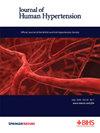Blood pressure variability in CKD patients with and without nocturnal hypertension
IF 3.4
4区 医学
Q2 PERIPHERAL VASCULAR DISEASE
引用次数: 0
Abstract
Nocturnal hypertension is highly prevalent in patients with chronic kidney disease (CKD) and represents a strong predictor of cardiovascular events. Increased blood pressure variability (BPV) is also independently associated with cardiovascular events in these patients. Differences in short-term BPV indices between CKD patients with and without nocturnal hypertension have not been previously studied. This study included 96 patients (73 with and 23 without nocturnal hypertension) who underwent 24-h ambulatory BP measurement. Standard deviation (SD), weighted SD (wSD), coefficient of variation (CV), and average real variability (ARV) of systolic (SBP) and diastolic blood pressure (DBP) were calculated using validated formulas for the 24-h and the respective daytime (07:00–23:00) and nighttime (23:00–07:00) periods. 24-h, daytime and nighttime SBP and DBP were higher in patients with nocturnal hypertension. During the 24-h period, wSD and ARV for 24-h SBP (wSD, 14.0 ± 3.8 vs 11.7 ± 3.1 mmHg, p = 0.009; ARV, 10.5 ± 2.7 vs 9.2 ± 1.9 mmHg, p = 0.035) and 24-h DBP were higher in patients with nocturnal hypertension. Regarding the daytime period, patients with nocturnal hypertension presented higher daytime SD and ARV for SBP (SD, 14.8 ± 4.0 vs 13.0 ± 3.6 mmHg, p = 0.008; ARV; 10.5 ± 3.2 vs 9.1 ± 2.0 mmHg, p = 0.016) and DBP, with daytime SBP and DBP CV being numerically but not significantly higher (p = 0.110 and p = 0.08 respectively). During the nighttime period, no significant differences between groups were present for all nighttime BPV indices. In conclusion, CKD patients with nocturnal hypertension have higher systolic and diastolic BPV indices during the 24-h and daytime periods, but not the nighttime period. These findings signify that increased BPV may be responsible for higher cardiovascular risk in CKD patients with compared to those without nocturnal hypertension.伴有和不伴有夜间高血压的CKD患者血压变异性。
夜间高血压在慢性肾脏疾病(CKD)患者中非常普遍,是心血管事件的一个强有力的预测因子。升高的血压变异性(BPV)也与这些患者的心血管事件独立相关。有和没有夜间高血压的CKD患者之间短期BPV指数的差异此前没有研究。本研究包括96例患者(73例有夜间高血压,23例无夜间高血压),他们接受了24小时动态血压测量。采用经过验证的公式计算收缩压(SBP)和舒张压(DBP)的标准偏差(SD)、加权SD (wSD)、变异系数(CV)和平均真实变异性(ARV),分别为24小时和白天(07:00-23:00)和夜间(23:00-07:00)。夜间高血压患者24小时、白天和夜间收缩压和舒张压均较高。在24小时内,wSD和ARV对24小时收缩压(wSD, 14.0±3.8 vs 11.7±3.1 mmHg, p = 0.009;夜间高血压患者ARV(10.5±2.7 vs 9.2±1.9 mmHg, p = 0.035)和24小时DBP较高。夜间高血压患者白天收缩压SD和ARV较高(SD, 14.8±4.0 vs 13.0±3.6 mmHg, p = 0.008;抗逆转录病毒药物;10.5±3.2 vs 9.1±2.0 mmHg, p = 0.016)和舒张压,白天收缩压和舒张压CV数值上没有显著升高(p = 0.110和p = 0.08)。夜间,各组间夜间BPV指数均无显著差异。综上所述,伴有夜间高血压的CKD患者在24小时和白天有较高的收缩期和舒张期BPV指数,而在夜间没有。这些发现表明,与没有夜间高血压的患者相比,BPV升高可能是CKD患者心血管风险增加的原因。
本文章由计算机程序翻译,如有差异,请以英文原文为准。
求助全文
约1分钟内获得全文
求助全文
来源期刊

Journal of Human Hypertension
医学-外周血管病
CiteScore
5.20
自引率
3.70%
发文量
126
审稿时长
6-12 weeks
期刊介绍:
Journal of Human Hypertension is published monthly and is of interest to health care professionals who deal with hypertension (specialists, internists, primary care physicians) and public health workers. We believe that our patients benefit from robust scientific data that are based on well conducted clinical trials. We also believe that basic sciences are the foundations on which we build our knowledge of clinical conditions and their management. Towards this end, although we are primarily a clinical based journal, we also welcome suitable basic sciences studies that promote our understanding of human hypertension.
The journal aims to perform the dual role of increasing knowledge in the field of high blood pressure as well as improving the standard of care of patients. The editors will consider for publication all suitable papers dealing directly or indirectly with clinical aspects of hypertension, including but not limited to epidemiology, pathophysiology, therapeutics and basic sciences involving human subjects or tissues. We also consider papers from all specialties such as ophthalmology, cardiology, nephrology, obstetrics and stroke medicine that deal with the various aspects of hypertension and its complications.
 求助内容:
求助内容: 应助结果提醒方式:
应助结果提醒方式:


